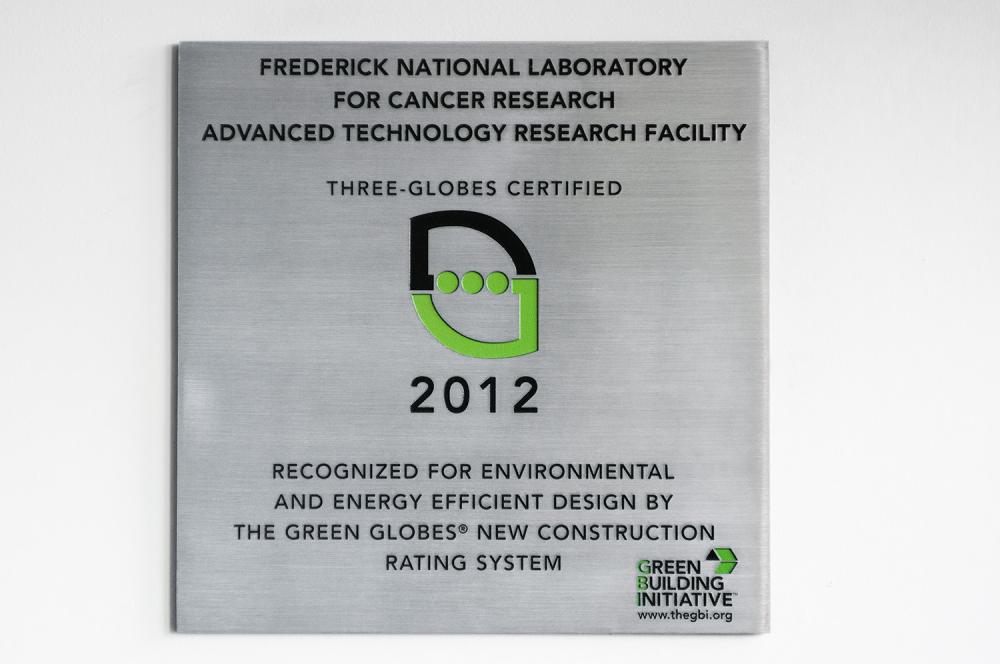By Ashley DeVine, Staff Writer
From project management and energy and water efficiency to emissions and the indoor environment, the Advanced Technology Research Facility (ATRF) was built with sustainability in mind, exceeding the National Institutes of Health’s (NIH’s) building standards and earning three Green Globes from the Green Building Initiative (GBI).
The ATRF was scored at 72.3% based on GBI’s assessments in the categories of project management, site, energy, water, resources and solid waste, emissions, and the indoor environment. This score equated to three Green Globes out of a possible four, meaning that the building’s environmental attributes demonstrate “leadership in energy” and environmental efficiency, and “a commitment to continual improvement,” according to Green Globes ratings information.
For new construction, NIH requires buildings to be Green Globe or LEED (Leadership in Energy and Environmental Design) certified. The ATRF was designed with a goal of earning at least two Green Globes, even though NIH only requires one.
“We made a conscious effort to get at least two because we knew we could easily get one Green Globe,” said Chud Wright, senior designer, Facilities Maintenance and Engineering (FME), SAIC-Frederick. “The way we managed it, we just worked real hard with the architectural and engineering firms to come up with relatively inexpensive ways to make energy and water conservation designs.”
The amount of construction waste recycled during the ATRF’s construction also exceeded requirements. Green Globes requires 50 percent recycling of construction waste—the ATRF’s recycling rate was 88 percent (1,050 tons).
Every rock excavated from the construction site—more than one million pounds—was used in the building’s construction or in road beds.
Sustainability Features: Water Recycling and Energy Savings
The ATRF is positioned to maximize the amount of sunlight it receives. All the rooms have automatic dimmers so that in the daytime, the lights automatically dim to save energy. “Even when you leave your office, tied into your lighting sensor is your HVAC sensor, so you’re not heating and cooling a room when it’s not occupied,” Wright said.
Two of the building’s major sustainability features are water recycling and chilled beams. Active chilled beams heat and cool the laboratories, providing a minimum energy savings of 35% over a standard laboratory. Active chilled beams contain chilled water coils that take outside air induced by air handlers and distribute it evenly across the coils. “As the air passes through the chilled beam, it cools (or heats) the lab air, which falls into the occupied zone,” Wright said.
The ATRF’s water recovery system is designed to recoup two million gallons of water per year by collecting the condensate from the air handling units and capturing wastewater. The condensate is produced when the air handlers take the moisture out of the air—as a traditional air conditioner does. The water generated from the air handlers is stored in a 3,000-gallon tank. “So we’re capturing two water streams that would normally be dumped down the drain, and then we use that for cooling water,” Wright said. The cooling water is used to indirectly chill the chilled beams.
Water is also used to cool the data center, where all of the ATRF’s computer storage is housed. Cooling the data center is equivalent to cooling more than 1,000 Maryland homes, according to Len Wrona, manager of Engineering, FME. The equipment racks, which can sometimes hold 20 to 30 servers, include in-door chilled water cooling to bring the cooling medium close to the heat source. “In a normal data center, you’d have an air conditioner sitting on the exterior of the walls just dumping cold air, but it doesn’t really capture the heat right there where it’s being generated,” Wright said.


